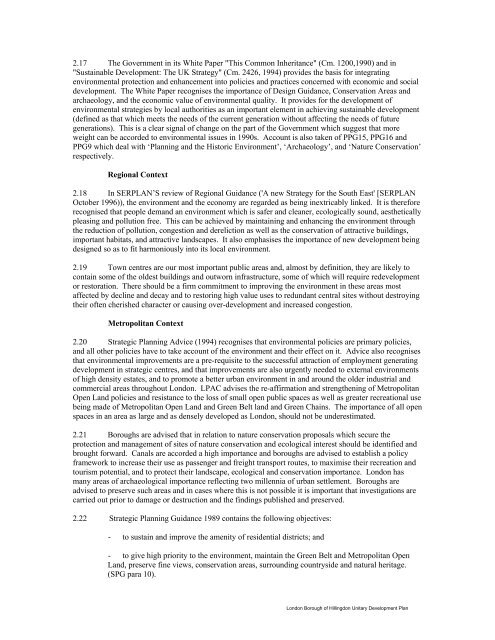HILLINGDON UNITARY DEVELOPMENT PLAN - London Borough ...
HILLINGDON UNITARY DEVELOPMENT PLAN - London Borough ...
HILLINGDON UNITARY DEVELOPMENT PLAN - London Borough ...
Create successful ePaper yourself
Turn your PDF publications into a flip-book with our unique Google optimized e-Paper software.
2.17 The Government in its White Paper "This Common Inheritance" (Cm. 1200,1990) and in<br />
"Sustainable Development: The UK Strategy" (Cm. 2426, 1994) provides the basis for integrating<br />
environmental protection and enhancement into policies and practices concerned with economic and social<br />
development. The White Paper recognises the importance of Design Guidance, Conservation Areas and<br />
archaeology, and the economic value of environmental quality. It provides for the development of<br />
environmental strategies by local authorities as an important element in achieving sustainable development<br />
(defined as that which meets the needs of the current generation without affecting the needs of future<br />
generations). This is a clear signal of change on the part of the Government which suggest that more<br />
weight can be accorded to environmental issues in 1990s. Account is also taken of PPG15, PPG16 and<br />
PPG9 which deal with ‘Planning and the Historic Environment’, ‘Archaeology’, and ‘Nature Conservation’<br />
respectively.<br />
Regional Context<br />
2.18 In SER<strong>PLAN</strong>’S review of Regional Guidance ('A new Strategy for the South East' [SER<strong>PLAN</strong><br />
October 1996)), the environment and the economy are regarded as being inextricably linked. It is therefore<br />
recognised that people demand an environment which is safer and cleaner, ecologically sound, aesthetically<br />
pleasing and pollution free. This can be achieved by maintaining and enhancing the environment through<br />
the reduction of pollution, congestion and dereliction as well as the conservation of attractive buildings,<br />
important habitats, and attractive landscapes. It also emphasises the importance of new development being<br />
designed so as to fit harmoniously into its local environment.<br />
2.19 Town centres are our most important public areas and, almost by definition, they are likely to<br />
contain some of the oldest buildings and outworn infrastructure, some of which will require redevelopment<br />
or restoration. There should be a firm commitment to improving the environment in these areas most<br />
affected by decline and decay and to restoring high value uses to redundant central sites without destroying<br />
their often cherished character or causing over-development and increased congestion.<br />
Metropolitan Context<br />
2.20 Strategic Planning Advice (1994) recognises that environmental policies are primary policies,<br />
and all other policies have to take account of the environment and their effect on it. Advice also recognises<br />
that environmental improvements are a pre-requisite to the successful attraction of employment generating<br />
development in strategic centres, and that improvements are also urgently needed to external environments<br />
of high density estates, and to promote a better urban environment in and around the older industrial and<br />
commercial areas throughout <strong>London</strong>. LPAC advises the re-affirmation and strengthening of Metropolitan<br />
Open Land policies and resistance to the loss of small open public spaces as well as greater recreational use<br />
being made of Metropolitan Open Land and Green Belt land and Green Chains. The importance of all open<br />
spaces in an area as large and as densely developed as <strong>London</strong>, should not be underestimated.<br />
2.21 <strong>Borough</strong>s are advised that in relation to nature conservation proposals which secure the<br />
protection and management of sites of nature conservation and ecological interest should be identified and<br />
brought forward. Canals are accorded a high importance and boroughs are advised to establish a policy<br />
framework to increase their use as passenger and freight transport routes, to maximise their recreation and<br />
tourism potential, and to protect their landscape, ecological and conservation importance. <strong>London</strong> has<br />
many areas of archaeological importance reflecting two millennia of urban settlement. <strong>Borough</strong>s are<br />
advised to preserve such areas and in cases where this is not possible it is important that investigations are<br />
carried out prior to damage or destruction and the findings published and preserved.<br />
2.22 Strategic Planning Guidance 1989 contains the following objectives:<br />
- to sustain and improve the amenity of residential districts; and<br />
- to give high priority to the environment, maintain the Green Belt and Metropolitan Open<br />
Land, preserve fine views, conservation areas, surrounding countryside and natural heritage.<br />
(SPG para 10).<br />
<strong>London</strong> <strong>Borough</strong> of Hillingdon Unitary Development Plan
















